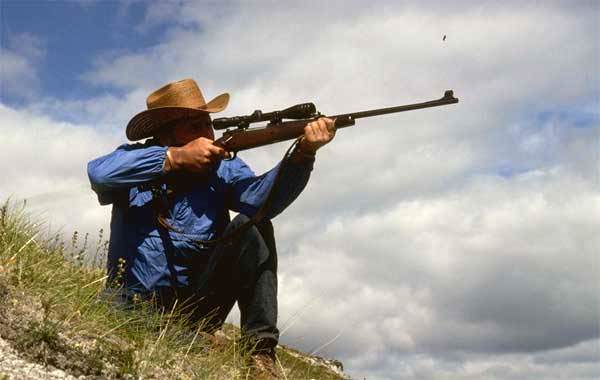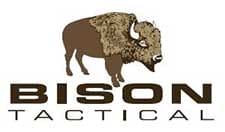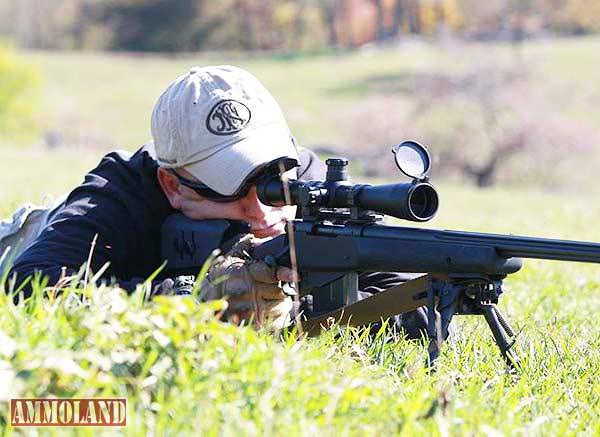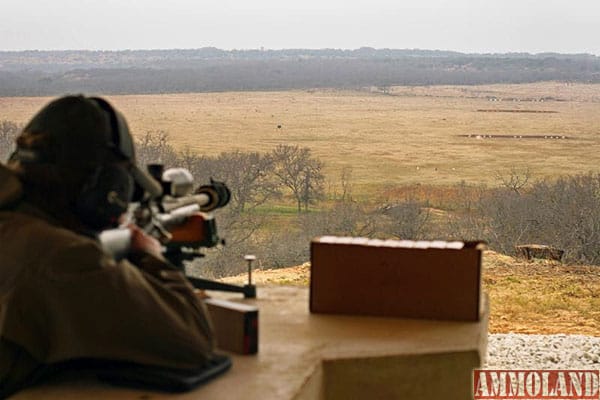

Colorado – -(Ammoland.com)- When it comes to both competitive precision rifle shooting and (rifle) hunting, there is a substantial amount of overlap in skills and gear a sportsman may utilize.
Without getting into the infinitely fine details of these shooting sports we can cover some of the main points on what both hunters and competitors can do to improve their skill set, and their basic gear loadout. Also, if you’re a hunter interested in changing gears into competitive shooting, this will give you an idea of what the competitor focuses on to achieve similar goal of “rounds on target”.
Many people overlook the fact that in all shooting sports, individuals who wish to excel will first need to understand and instill the correct fundamentals of marksmanship.

This amounts to creating a steady shooting position, controlling your breathing to fire at a natural respiratory pause, trigger finger control with follow-through, and recoil management. These aspects of your firing regimen are important because you need to find the manner in which you shoot the most accurately, and be able to do that in a repeatable fashion every time you pull the trigger. Consistency in everything you do matters in precision shooting because it removes variables so the shooter can make calculated hits. If the shooter misses the target he will most likely have a better idea as to why if his techniques, ammunition, and equipment are consistent.
Needless to say, mastery of the basics leads to a greater degree of accuracy in the field. The only way to gain this skill and all shooting skills is to practice, and if necessary, receive training from professionals.
Shooting Practice
Nothing improves positional shooting accuracy more than practice. People who can afford live fire practice tend to fire many rounds in training, but that’s not totally necessary. The option is “dry fire” practice. That’s taking a safe, unloaded rifle and setting up improvised positions, holding your reticle on target and pulling the trigger. This type of practice is quite literally free of charge. You can do this at home, at the range, or even in a hotel room. A professional shooter friend recommended setting up a six foot ladder, and dry firing 2 rounds from each rung. This gives you a variety of heights and forces you to reload if you’re doing live fire practice. Otherwise, you can set up positions you’ve encountered in the field or in competition. Your creativity is the limit. This exercise will make you feel accustomed to getting into uncomfortable positions.

Challenge yourself to complete tasks in smaller periods of time. You’ll soon learn to build those shooting positions with ease and in a quicker amount of time with little effort or thought. Also, don’t forget to occasionally practice shooting off-hand using your rifle sling in standing, sitting, and kneeling positions. This is common in competition and you may find it most prudent in a field hunting scenario. Most importantly, you will become more familiar with your rifle and support gear.
You don’t want to be deploying sticks, tripods, and support bags on the clock at a match for the first time, and definitely not on the hunt of a lifetime.
For the purpose of “precision rifle” in this article we are assuming the use of a rifle capable of grouping at least 1 MOA to its effective range. The action type and cartridge used for this conversation are irrelevant, but the repeatability of the chosen rifle and ammunition combination is important. Another must-have is a rear shooting bag of some sort. It could be a sock full of rice or a more robust nylon sewn bag or a tool like Edgewood Softy Rear Bag. For prone or bench rest shooting, the bag can increase accuracy by 60%. No rifle is complete without a sling for carry in the field and for a means of support. Some of the many styles and brands are listed here, but find a sling that suits your needs and keep it attached to the rifle. In addition to the sling, a bipod will be required. They are essential to prone or bench shooting and can be good improvisation tools in setting up firing positions. Also, we know that regardless of branding or style, each type of sportsman will require an optic that has an appropriate reticle for hold-overs, holding wind, and even exposed turrets for dialing DOPE. The price and quality of the optic are options, but the most important aspect of the piece be that it is repeatable, or that it tracks the same each time it’s dialed and returns to zero. Another aspect of the optic to consider is the denomination of measurement it uses. Both MOA and MIL are used widely, but you may want to gravitate towards the one most people around you use. This makes communication with spotters much faster and simpler.
Shooting Gear

Oftentimes hunters may need to be able to take shots further off of the ground to see over brush or terrain than a bipod is good for. In competition this is called “positional” shooting. Most opt for some type of light shooting stick setup or homemade V heads on tripods or sticks to overcome the problem. Competition shooters are also required to shoot over artificial barricades or required to follow stage rules to get the shooter off the ground, in which case the sticks can serve a double duty for your competition setup or your hunting rifle. In this department you will see as many different setups as you see shooters. Everything is used from repurposed hiking poles to carbon fiber tripods and heads and wooden sticks.
If you want something ready-made, Feisol makes an excellent tripod in carbon fiber that can hold much more than your rifle weighs and is extremely light for its size.
The makeup and cost of your chosen shooting setup do not matter as much as how well you can utilize it. If you’re going to be carrying all of this gear, you will want to choose a combination that is as light as you can allow to save you pain down the trail.
If you trust industry experts like ballistician Bryan Litz, you know that the correct range to the target is possibly the most important piece of data the shooter can have. Even with perfect DOPE, a shooter with an incorrect range cannot score impacts. While you can rely on eye-estimates or reticle ranging techniques, the quickest and most accurate way to determine range is through the use of a quality laser rangefinder. These are available in handheld monocular versions, as well as in powerful binocular style optics. Leica is an industry leader which makes both types of optics. The Leica Geovid Binoculars are incredibly accurate and fast. The glass clarity is second to none and Leica sets a gold standard with their ranging products. The field of view in the binoculars is excellent and adept for spotting small steel targets and ranging even animals at distances further than most people care to shoot game. For the shooter on a tighter budget, the Leica Rangemaster CRF 2000-B model is an accurate rangefinder in a tighter monocular package.
It is important to note that while monocular-style range finders can work very well, field conditions may require the use of binoculars. In a hunting scenario, you’re going to want the largest field of view possible to see your game in more detail. This is especially true if there is anything partially obscuring your view. Binocular vision also gives you depth perception which is a bonus if you are ranging game through brush and receive multiple readings. You can then infer which range is most likely correct. In field-type competition shooting where the shooter may not know the location and range of the available targets, binoculars offer much quicker target acquisition in the same manner in contrast to the smaller rangefinders. The steel tends to pop out of the background much more easily with added depth perception.

Shooters D.O.P.E.
Aside from understanding the intricacies of ballistics, all shooters need to have access to the DOPE (Data On Previous Engagements) half of that larger equation. For instance, many hunters like to write their ballistic drop in inches or MOA per yard on the stock of their rifle for quick reference while in the field. Or, if they have a preference to dial a scope turret or hold using mil dots, they may have that corresponding data stuck inside their scope cap. While rudimentary, these tactics can be very useful and effective.

However, if the shooter is attempting shots past around 600 yards, their ballistics will start to change drastically in a shorter distance and changes in atmospheric conditions start to matter more. In that case the shooter may want to have full detailed range cards prepared on paper or digitally. Ballistic Calculators (free one) are an invaluable tool if you tend to shoot in different areas of the country or if you just want to be able to dial your dope in tighter than just values every 50 yards. Of course, you can also just shoot all of your selected ranges and record your data to a range card, but it may not be as versatile as a digital calculator solution – especially if you travel to different elevations and climates.
Possibly the easiest method of finding your firing solution is the Kestrel meter. It automatically takes all the environmental data, including wind, and gives you a firing solution in real time if you prefer, or it can display range-card style data. Both the Kestrel 4500 and 5000 series units are capable of those tasks.
Be mindful of the old adage “garbage in, garbage out” when using any calculator. All the information you input needs to be as accurate as possible. You’ll also need to know the muzzle velocity of your bullet to get an accurate calculation. The easiest means for this is a chronograph. The Magnetospeed V3 Chronograph is an excellent chronograph that is very easy to use and accurate. It literally measures velocity at the muzzle and gives you all the pertinent information in any string of fire you prefer.
The bottom line is that if you practice with what you have available to you and fill in the blanks on some gear you may be missing, you could get into competition shooting rather quickly. Don’t be afraid to take the skills and gear you utilize in the field to a local monthly match to learn some new tricks, or to approach a precision rifle instructor for a slot in a class.
Virtually everyone you meet on the firing line is going to be willing to help you and answer questions. Stick with the fundamentals of marksmanship and you’ll already have what it takes to get started.
About Bison Tactical
Bison Tactical sells and develops products for competitors in tactical field shooting matches. We know our sh*t when it comes to gear because we use the same gear we sell. We encourage setting up an appointment to meet if you would like to stop by and visit. We have our FFL and SOT so can handle NFA as well as conventional firearm transfers. Learn more at www.bisontactical.com

Great article, I’ve been researching this and it sums up everything perfectly.